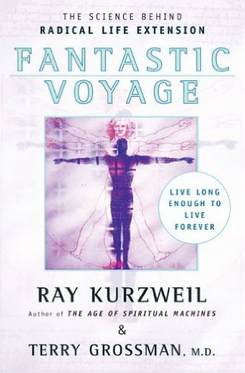Live long enough to live forever (the science behind radical life extension)
by Ray Kurzweil and Terry Grossman M.D.
2004, Rodale Publishing, 378 pages
 Editor’s Note: Still ‘cleaning out the closet,’ transferring older book reviews that were posted via the old nuts and bolts Dreamweaver formatted Website. I’m getting toward the bottom of the barrel, and most of the remaining books—such as the previous week’s book review of The Audacity of Hope that someone ghostwrote for criminal in chief Barry Soweto—I wonder what hallucinigenics I was ingesting for looking at them favorably back when I wrote the reviews. My reservations likewise exist with anything Ray Kurzweil has done… mainly because I have this perception that he has now gone over to the Dark Side by hiring on as a head honcho at ‘always do what’s evil and creepy’ Google.
Editor’s Note: Still ‘cleaning out the closet,’ transferring older book reviews that were posted via the old nuts and bolts Dreamweaver formatted Website. I’m getting toward the bottom of the barrel, and most of the remaining books—such as the previous week’s book review of The Audacity of Hope that someone ghostwrote for criminal in chief Barry Soweto—I wonder what hallucinigenics I was ingesting for looking at them favorably back when I wrote the reviews. My reservations likewise exist with anything Ray Kurzweil has done… mainly because I have this perception that he has now gone over to the Dark Side by hiring on as a head honcho at ‘always do what’s evil and creepy’ Google.
That may be. But reality is always more complex that what it appears at first, or even second, glance. Who knows what he’s doing over there in the bowels of global mind control, plotting the end of humankind as we know it? Well, most of the stuff he wrote about when he first took an interest in radical life extension was sans central government coordinated or approved. Legitimate ideas and discoveries by a man who seemed genuinely human—even though hopeful of an enhanced or transhumanist future. Politically, I can’t vouch for anything he’s doing today, but back when he wrote this book, I liked what he was advocating.
###
A review of Fantastic Voyage appeared in my Oakland (Oakland County, Michigan) Press early in 2005. As a longtime enthusiastic advocate—though not necessarily the most ardent practitioner—of life extension technology, I was ecstatic!
Here was a book about radical life-extension appearing in a ho-hum review geared to (what some say is) the cultural-literary wasteland of Detroit suburbia. The vitalist movement had just achieved a major breakthrough into common humanity… at least the branch of common humanity that reads.
Note: Terminology is still a bit tenuous in this transhumanist era we’re coming upon. But a vitalist is sort of a practical immortalist, someone who wants to extend life (with youthfulness and vigor) indefinitely, and generally thinks it can be accomplished in our natural lifetimes.
I’ll use the term vitalist to identify the movement Kurzweil, Grossman, and many others are pushing. The significance of their book is enormous: Just as Durk Pearson and Sandy Shaw (with Life Extension: A practical, scientific approach (1982)) were to health supplements, Kurzweil and Grossman are to the universal prospect of living well for a long time.
The authors break down our pursuit of effective vigorous immortality into three phases:
- Bridge 1: Ray and Terry’s Longevity Program: present-day nutrition, exercise, and wellness strategies that can get you to the next bridge.
- Bridge 2: The biotechnology bridge, where we learn how to turn off the bad genes and turn on the good ones, and figure out the biochemical clues for keeping body and mind the best.
- Bridge 3: What they refer to as the nanotechnology-AI (Artificial Intelligence) revolution, where we can rebuild our bodies and brains at the molecular level.
The prediction: generally effective Bridge 2 vitalist technologies begin 2010, with the beginnings of Bridge 3 technologies in 2020… with full flowering of those technologies a decade following those inception points.
The book is a reference manual on how to live right. I’m using it to determine my ideal weight and eat correctly, and it’s working. Moreover, the authors give us the science-fiction sounding realities of Bridge 2 and Bridge 3 technologies.
The upshot is if you can survive for 20 more years, chances are you will be (effectively) immortal. (Earth can always be struck by a meteor or supervolcano.)
Author/inventor Ray Kurzweil is the motive power behind this innovative branch of the vitalist movement. Please take three hours and watch his recent CSpan2 interview to understand the importance of his ideas to our future.
Ray shares that as a youth he was an avid fan of the Tom Swift adventure novels. In those novels—written from the beginning of the 20th century to mid-century—the teenage Tom would encounter problems with people or nature, then use his imagination to solve them—usually with a brilliant invention.
If there’s a better argument for reading fiction, I haven’t heard it.
This post has been read 1479 times!


